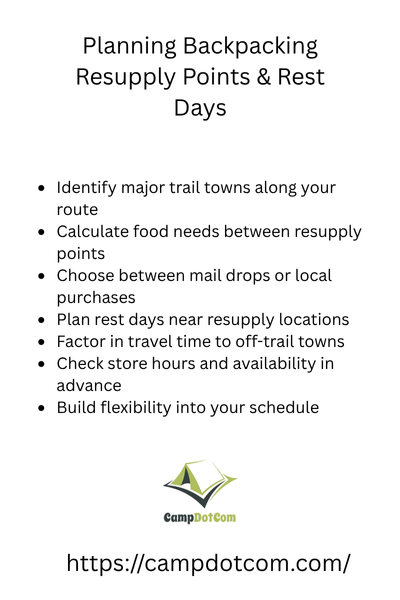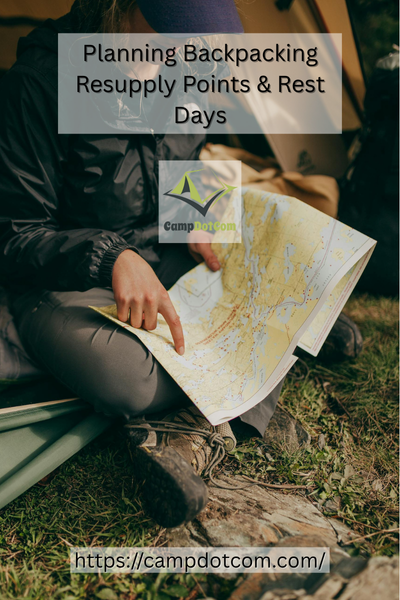Planning backpacking resupply might sound like something only super organized spreadsheet lovers get excited about, but believe me, even relaxed hikers learn that a little planning makes a big difference out on the trail.
I remember my first long distance backpacking trip. It was just me, my oversized pack, and about six days of trail mix. I figured I could just go with the flow when it came to food drops and rest stops. Well, I was wrong.
By day four, I was hungry, tired, and dreaming about greasy diner food and a soft bed. That is when I promised myself I would never head out again without carefully planning my resupply points and rest days.
As an Amazon Associate, I earn from qualifying purchases. Some of the links in this article are affiliate links. This means that, at zero cost to you, I will earn an affiliate commission if you click through the link and finalize a purchase.
Read More About Planning Backpacking Resupply Points & Rest Days

Why Planning Resupply and Rest Stops Is Actually Kinda Awesome
Look, I get it. Backpacking is all about freedom, nature, and escaping the daily grind. But when your stomach is growling and you haven’t showered in days, you might start craving the very thing you set out to avoid—a plan.
More Things to Know About Planning Backpacking Resupply Points & Rest Days

Backpacking planning resupply points and rest days doesn’t make your trip less adventurous. If anything, it helps you enjoy the adventure more. You’ll have the peace of mind knowing you won’t run out of food halfway up a mountain or push your body beyond what it can recover from.
And honestly? There’s something pretty satisfying about mailing yourself a box of goodies and finding it waiting for you in a tiny town post office.
Timing Is Everything
When I plan out my resupply stops, I start by looking at my average pace. If I’m doing, say, 15 miles a day, I know I’ll need a resupply every four to six days. That means I’m carrying less food weight, which makes everything easier (especially those steep climbs).
But here’s the kicker: don’t just think in miles—think in terrain. Fifteen miles of flat trail is one thing. Fifteen miles up and down rocky slopes? Totally different beast. Adjust your schedule accordingly.
Same goes for rest days. You think you’ll power through without breaks, but your feet might have other plans. Planning backpacking resupply points & rest days gives you space to recover.
I like to build in a “zero day” (a full day off) every six to eight days, and maybe a “nero” (a near-zero day) when rolling into town for supplies.
Where to Resupply (And What to Expect)
Choosing resupply points is part art, part logistics. Some trails have trail towns conveniently spaced out, while others feel like food deserts.
You’ll want to look for places with either a grocery store, general store, or the option to send yourself a resupply box.
For example, when I hiked a chunk of the PCT, I learned the hard way that not every small town has what you need. One place had nothing but potato chips and canned corn. So yeah… definitely worth doing a little research ahead of time.
Pro tip: when planning backpacking resupply points & rest days, check if the post office has funky hours (some close early or aren’t open on weekends). No one wants to arrive Friday evening and wait until Monday to pick up food.
Rest Days: Not Just for the Weak
I used to think taking a rest day meant I wasn’t tough enough. But after nearly limping into town with blisters the size of golf balls, I learned better. Rest days are a smart move, not a sign of weakness.
Find a trail town with a cozy motel or a hiker hostel, maybe even a laundry machine (oh, the joy of clean socks!). Eat something warm and greasy, call your mom, stretch out those legs, and let your body bounce back.
Sometimes I treat myself to two nights. One night to just relax and be a little messy without worries, and another night to clean up and get ready to hit the trail feeling fresh and ready.
How to Pack for Resupplies Without Overthinking It
I used to go wild prepping resupply boxes. Like, Excel spreadsheet and color-coded snacks wild. Now I keep it simple. I know what works for me such as oatmeal, jerky, peanut butter packets, electrolyte mixes, instant coffee (non-negotiable), and something sweet for morale.
Don’t forget any meds or toiletries you might need. And if you’re doing a long trail, throw in a little motivational note to yourself. I once packed a Post-it that just said, “You’re crushing it!” It actually helped more than I’d like to admit.
So when you’re planning backpacking resupply points and rest days, ask yourself what you need to feel human again?
Final Tips for Strategically Planning Resupply Points and Rest Days
Planning backpacking resupply points and rest days is not about turning your trip into a rigid schedule. It is about setting yourself up to enjoy the trail more. You get to hike smarter, not harder.
You’ll still have plenty of room for spontaneous detours, breathtaking views, and those moments when you just sit and stare at the stars. But you’ll also have food in your belly, dry socks on your feet, and maybe even a slice of pizza in your hands.
And honestly? That’s the kind of balance I can get behind.
